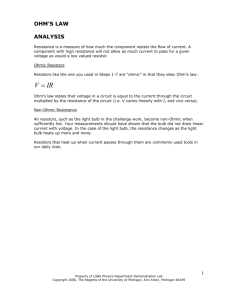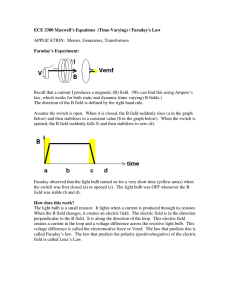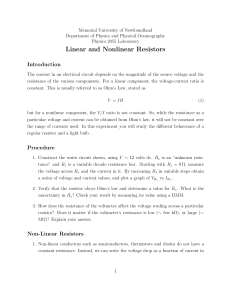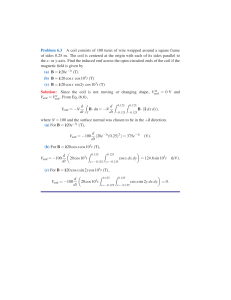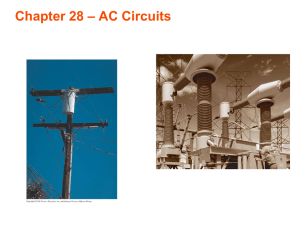electricity experiments
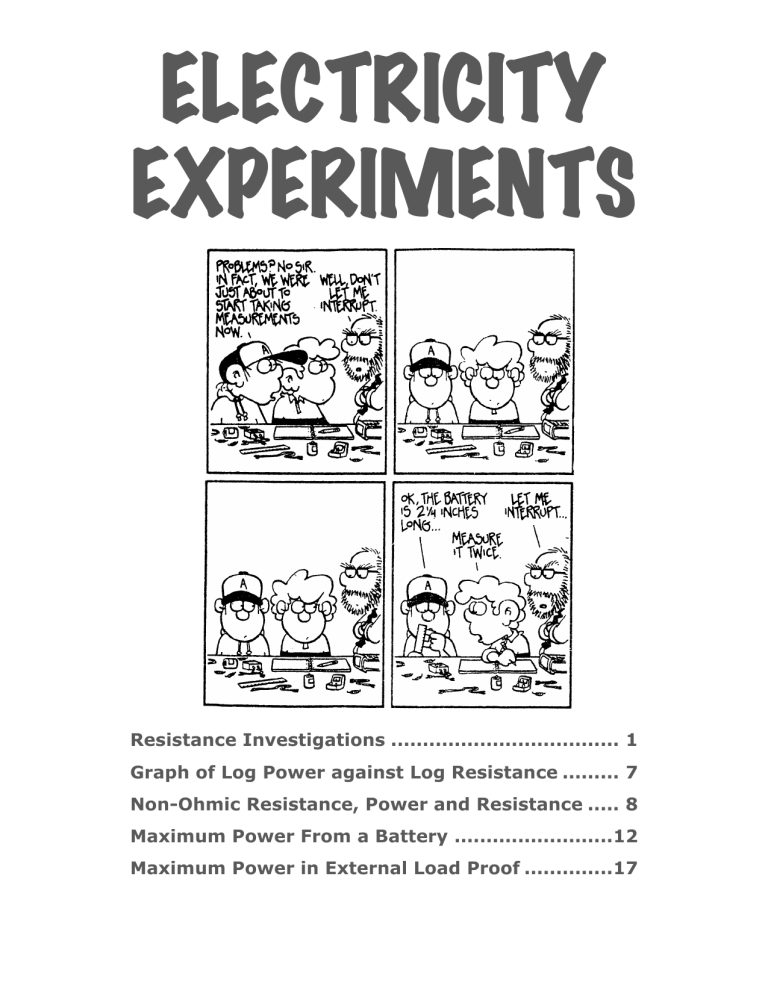
ELECTRICITY
EXPERIMENTS
Resistance Investigations .................................... 1
Graph of Log Power against Log Resistance ......... 7
Non-Ohmic Resistance, Power and Resistance ..... 8
Maximum Power From a Battery .........................12
Maximum Power in External Load Proof ..............17
Booklet File Name: Resistance.pdf
Dr. Mark Headlee
UWC–USA Physics
29 January 2010
RESISTANCE INVESTIGATIONS, VARIABLE APPLIED VOLTAGE
A simple Ohm’s Law circuit is made with a variable power supply. Students measure voltage and current over a range of values. Only voltage and current are recorded as raw data. Then processed data includes resistance, current squared, electrical power and the logarithms of power and resistance. The follow graphs are revealed.
MAXIMUM POWER FROM A BATTERY, VARIABLE LOAD RESISTANCE
Here students investigate the lost potential difference from a battery cell as the external load resistance increases. A graph of power against load reveals that the maximum power is obtained when the load resistance R and the internal resistance r are equal.
Booklet Page 1
RESISTANCE INVESTIGATION
RESISTANCE
ELECTRICAL RESISTANCE , denoted R , is a measure of how easily electric charge flows in a material. Conductors, semiconductors and insulators differ in their resistance to current flow. An ohmic material of significant resistance placed in an electric circuit to control current or potential difference is called a resistor .
The electrical resistance of a piece of material is defined by the ratio of the potential difference across the material to the current that flows through it.
Resistence =
Votlage
Current
The units of resistance are volts per ampere (V A -1
→ R =
V
I
). However, a separate SI unit called the ohm, denoted Ω , is defined as the resistance through which a current of 1 A flows when a potential difference of 1 V is applied. Since the term ‘significant resistance’ refers to a small resistance, it is common for a resistor to have kilo ohm (k Ω ) and mega ohm (M Ω ) values.
The resistance of a conducting wire depends on four main factors: length, cross-sectional area, resistivity (denoted ρ ) , and temperature. Resistivity is specific to the type of material being used as a wire and is affected by the nature of the delocalized electrons and the positive ions within the material. The resistance of a material increases with temperature because of the thermal agitation of the atoms it contains, as they impede the movement of electrons that make up the current.
OHM’S LAW
The German physicist, Georg Simom Ohm (1787-1854), studied the resistance of different materials systematically. In 1826, he published his findings for many materials including metals. He stated that:
Provided the physical conditions such as temperature are kept constant, the resistance is constant over a wide range of applied potential differences, and therefore the potential difference is directly proportional to the current flowing.
This is known as Ohm’s Law, denoted as follows with V for voltage and I for current.
V ∝ I →
V
I
= constant
Resistance.docx, Page 1
Booklet Page 2
There are two relevant statements to be made here. Firstly, Ohm’s Law is not really a law but rather an empirical statement of how materials behave. Many materials are non-ohmic and this law is only applicable to ohmic conductors. Secondly, the law should not be written as statement defines resistance.
R
= V I because this
The formula is commonly written as
V
= IR where V is the potential difference across the resistor in volts V, I is the current in the resistor in amperes A, and R is the resistance in ohms Ω . When written in this from R is understood to be independent of V .
As the current moves through the resistance of a device, it loses electrical potential energy. The potential energy of a positive charge is less upon leaving the resistor than it was upon entering. We say that there is a potential drop across the device.
A typical experimental apparatus setup and the resulting graph used in the confirmation of Ohm’s
Law are shown below. Note that the voltmeter is in parallel to the resistance and the ammeter is in series with the resistance.
OHMIC AND NON-OHMIC CONDICTORS
Devices that obey the linear relationship of current with voltage are called ohmic devices or ohmic conductors . There are very few devices that are truly ohmic although some metals can be if there is no temperature increase due to the heating effect of the current. However, many useful devices obey the law at least over a reasonable range. Remember that a resistor is any device with a potential difference and is not only restricted to the typical resistor used in the laboratory.
Resistance.docx, Page 2
Booklet Page 3
When a resistance device does not follow Ohm’s law, it is said to be non-ohmic. The filament lamp is non-ohmic because Ohm’s Law requires that the temperature remains constant, and this is not the case as the voltage increases across a filament lamp.
Resistances that do not obey Ohm’s Law can be useful electrical device, such as a filament of a light bulb, a diode, a thermistor, and so on. The graphs below show some typical voltage V against current I graphs for some non-ohmic conductors.
You will now conduct an experiment into the non-ohmic resistance of the filament of a light bulb.
INVESTIGATION ONE: RESISTANCE OF A LIGHT BULB
Set up a circuit using the equipment that is provided. Collect data of voltage and current over a range from 0 to 12 volts. Plot a graph of voltage against current (not current against voltage).
Resistance.docx, Page 3
Booklet Page 4
Now determine the resistance of the bulb at a low current and voltage setting and at its normal 12 V setting. This is when the bulb’s temperature is cold and when it is hot.
INVESTIGATION TWO (HIGHER LEVEL ONLY): POWER & RESISTANCE
Calculate the resistance R and the power P for each set of I and V data sets, where
R =
V
I and P = IV
The unit of resistance R are ohms, Ω , and the product of current I in amperes A and voltage V in volts V is power P in watts W.
Now construct a graph of power against resistance.
Resistance.docx, Page 4
Booklet Page 5
This should be a non-linear graph of how the power dissipated by an electric lamp varies with the resistance of the lamp’s filament.
As the filament of the lamp gets warmer (as the power increases due to the increased voltage and current) the resistance changes.
For a non-ohmic resistor, a good approximation for the relationship between the power dissipated and the resistance is in terms of two constant, k and n , given by the equation
= k R n
P
In order to obtain values for the two constant, the equation must be in the form that we can graph, such as a straight line. We can rearrange the relationship into the form
y
= m x + c using logarithms.
P = k R n ln P = ln kR n ln P = ln R n + ln k ln P = n ln R + ln k
The general graph equation
y
= m x + c has y as the y slope) of the graph, and any offset from the origin is c .
-axis, x as the x -axis, m as the gradient (or
You are to determine the exponential power, n , and the constant k by constructing a graph of the logarithm of power against the logarithm of resistance. The slope or gradient of the graph is the power factor, n . The graph’s y -intercept is the constant k value. Determine the units of this constant.
Resistance.docx, Page 5
Booklet Page 6
Your graph should look something like this sketch.
In addition to Ohm’s Law, Georg Ohm also proved that the resistance was depended upon the type of material and that it was proportional to the length of the wire and inversely proportional to the cross-sectional area of the conductor.
An interesting phenomenon of the effect of temperature on resistance is superconductivity . In
1911 H. Kammerlingth Onnes found that mercury loses all its resistance abruptly at a critical temperature of 4.1 K. When a material attains zero resistance at some critical temperature, it is called a superconductor. The possibility of having a material that has an induced electric current that lasts forever has become a topic for research physicists. Just think of the energy saving if the perfect superconductor is found that can give zero resistance at room temperature?
Resistance.docx, Page 6
Booklet Page 7
LOG OF POWER AGAINST THE LOG OF RESISTANCE
FOR A NON-OHMIC LAMP
Updated: February 2010
Resistance.docx, Page 7
Booklet Page 8
DATA PROCESSING WITH LOGARITHMS
Investigating the Non-Ohmic Resistance of a Light
Bulb and Determining the Relationship between the Power and Resistance
The voltage is varied for a filament light bulb and the raw data of voltage and current are recorded for a range from about 1.0 V to 11.0 V. The resulting current ranged from about 0.5 A to 1.6 A. A graph of voltage against current would be linear and proportional for a ohmic resistance. The data does not suggest this. As the voltage across the light bulb increases, the current increases, but the bulb also gets brighter and hotter. Its resistance is chaning too. The graph-line fit function is selected to an equation of the form y = A^B. Here, y = voltage,
A = current and B is the exponent to current for the curved line fit. The computer tells us that
B = 1.99 or about B = 2.
Next a graph of voltage against the square of current is drawn in order to confirm the previous equation. Sure enough, there is a correlation of 1.00 and an intercept of 0.003 V, which is the same as zero volts. The extension of the curved line in the first graph is now justified. It is safe to claim that V proportional I 2 .
Graphs Light Bulb.docx, Page 1
Booklet Page 9
What we really want to know is the relationship of power to resistance. A graph of power against resistance suggests that P is proportional to R 3.03
or about R 3 .
To make sure this curve is correct we graph the logarithm of power against the logarithm of resistance. Here we find the gradient of 2.95 or about 3, confirming the cube relationship. This also justifies the previous graph’s curved line going to the origin.
Graphs Light Bulb.docx, Page 2
Booklet Page 10
Finally, a graph of power against resistance cubed is drawn. The correlation is perfect, and the intercept offset is only 0.02 W or about zero. We can feel justified that within the range of the experimental data that power is proportional to the cube of the resistance.
A graph of power against resistance cubed is as expected (see the next page).
Graphs Light Bulb.docx, Page 3
Booklet Page 11
P
∝
R 3
Updated: 29 January 2010
Graphs Light Bulb.docx, Page 4
Booklet Page 12
THE MAXIMUM POWER OF A BATTERY
ICT with spreadsheet and graphing software
A Radio Shack Heavy Duty 6 Volt Lantern battery (#23-016) is investigated to determine its internal resistance. It is also shown that the maximum power output of the battery occurs when the load resistance is equal to the internal resistance.
A digital voltmeter is connected across the battery. A 0-25 Ω potentiometer is connected in series with a digital ammeter and then connected across the battery. For low resistance, a number of one-ohm power resistors are connected together in series and parallel. Data of current and voltage is recorded into a spreadsheet. The spreadsheet is then used to calculate resistance, power and the reciprocal of current.
Because a large current is drawn from the battery, meter readings varied somewhat with time. To get a reliable reading, I waited for the voltage to stabilize and then read both the voltmeter and ammeter. The least count on the digital meters was
0.01V and 0.01A. The current varied several hundredths of an ampere, so to adjust for both meter’s uncertainties and variations I assume no uncertainty in the voltage but ±0.05A in the current.
The terminal potential difference is V tpd
or just V , the total potential difference of the battery is the emf or
V emf
, the current is I , the load resistance is R
(calculated as t.p.d. voltage divided by current), the internal resistance of the cell is r , and the power
(calculated as the product of voltage and current) is P .
Max Power.docx, Page 1 of 1
Spreadsheet
Booklet Page 13
Experimental Data
Raw Data
Voltage V / V
Current I / A
Processed Data in Spreadsheet
Resistance: R
=
V
/
Ω
I
Power: P
=
IV / W
Reciprocal of Current
1
I
= I
−
1 / A
−
1
The current I and voltage V are measured as a load R is varied from about 25 Ω to a short circuit.
A graph of terminal potential difference against current is graphed below. By extrapolation we see that when there is no current the terminal potential difference would be 6.27 V. This is the e.m.f. of the cell, V emf
=
6.27V
. The best straight-line gradient is –0.970 V/A.
Max Power.docx, Page 2
Booklet Page 14
The next graph is the same information as above but with only the minimum and maximum gradients based on the first and last data points drawn.
Here is a close up view of the voltage intercepts. From this information the uncertainty in the best straight line gradient is found.
V emf
±
V emf
Δ
V emf
± Δ
V emf
=
V
Best
± Δ
V
=
V
Best
=
6.27
V
±
⎝⎜
⎛ 6.38
V
−
6.27
V
2
⎠⎟
⎞
±
V
Max
− V
Min
2
≈ (
6.27
±
0.06
)
V
Max Power.docx, Page 3
Booklet Page 15
A graph of load resistance against the reciprocal of current reveals a current with no load. This current is due to the internal resistance of the cell, and by extrapolation, the y -intercept is equal to the internal resistance. In this case, 1.04 Ω or about r = 1.0 Ω .
V emf
=
Ir
+
IR
= ( +
R
) →
V emf
I
= r
+
R
→
R
=
V emf
I
− r
Hence the equation of the shape y
= mx
+ c is R =
( )
⎝⎜
⎛ 1
I
⎠⎟
⎞
− r
− r
= −
1.01
Ω → r
≈
1.0
Ω
Consider next a graph of output power P against the load resistance R .
The two highest power load resistances are 0.75
Ω and 1.10
Ω . This gives an estimated average maximum power load resistance of R
MaxPower
=
0.75
Ω +
1.10
Ω
=
0.925
Ω ≈
0.93
Ω . Given the
2 uncertainties here, we can say that the R
MaxPower
≈
1.0
Ω .
The current in terms of emf is V emf
= V tpd
+ V lost
= IR + Ir → I =
V emf
R + r
.
Power is P max
= I 2 R =
⎛
⎝⎜
V emf
R + r
⎞
⎠⎟
2
R =
V 2 emf
(
R
+ r
)
2
R =
R 2
V 2 emf
R
+ 2 Rr + r 2
=
V 2 emf
(
R
− r
)
2
R
+
4 Rr
.
Max Power.docx, Page 4
Booklet Page 16
For maximum power, make the denominator minimal or R − r = 0 , hence R = r .
For R
= r , we now have P max
=
V 2 emf
4 R r
R
=
V 2 emf r
4 r r
=
V 2 emf
4 r
. Using the values from the graph the maximum power is calculated: P max
=
V 2 emf
4 r
=
(
6.28V
)
2
( Ω )
= 9.8596W
≈ 10 W
The maximum power occurs when the load is equal to the internal resistance, R = r ≈ 1.0
Ω .
In summary, the cell’s emf is V emf
± Δ V emf
( ≈ 6.27
± 0.6
)
V , the internal resistance of the battery is r
± Δ r
= (
1.0
±
0.1
) Ω , and the maximum power from the battery is P max
± Δ
P
= (
10
±
1
)
W .
The uncertainty in the e.m.f. is based on the minimum and maximum gradients of a graph, and the internal resistance uncertainty is based on the number of significant figure as is the power uncertainty.
Max Power.docx, Page 5
Booklet Page 17
MAXIMUM POWER IN EXTERNAL LOAD
From the conservation of energy, where R = load resistance, and r = internal resistance.
V emf
= V tpd
+ V lost
= I R + I r = ( + r
)
I
=
V emf
R + r
From the expression of electrical power of the load resistance:
P
L
= I
2
R =
V emf
R
+ r
2
⋅ R =
V
2 emf
(
R
+ r
)
2
⋅ R
Where
(
R
+ r
) 2 =
R
2 +
2 R r
+ r
2 and, where
(
R
− r
) 2 =
R
2 −
2 Rr
+ r
2 , we can write:
(
R + r
) 2 = (
R − r
) 2 + 4 Rr , hence
P
L
=
V
2 emf
(
R + r
)
2
⋅
R
=
V
2 emf
(
R − r
)
2 + 4 Rr
⋅
R
For maximum power in the load R , we want the denominator to be as small as possible. This is when R
− r
=
0 , which is to say that R
= r . Therefore:
P
L
=
V
2 emf
( r
− r
)
2 +
4 Rr
⋅ R =
V
2 emf
4 R r
⋅ R =
V
2 emf
4 r
Conclusion: for the maximum power in the load resistance R , we want it to be equal to the internal resistance of the battery, r .
∴
P
R (max)
→
R
= r
Max Power.docx, Page 6
Booklet Page 18
Another way for the same answer starts with total power: P
Total
= P
Load
+ P
Internal
P
T
= P
L
+ P
I
→
P
L
= P
T
−
P
I
= I V emf
−
I
2 r =
( emf
−
I r
)
We can multiply by r r
to get P
L
= r r
⋅
( emf
−
I r
)
, hence:
P
L
=
( emf
−
I r
) r
For the maximum power on the load resistance, we can see that we must equate " Ir " with
"
V emf
−
I r
"
. The proof is left to you. So, we decide upon the following condition:
I r ≡
(
V emf
− I r
)
From this condition, we can write
I r
=
V emf
−
I r
→
I r
+
I r
=
V emf
→
2 I r
=
V emf
→
V emf
=
I
( )
Therefore where V emf
=
I
( ) =
I r
+ r
)
and where R = r , we get V emf
= ( + r
)
∴
V emf
=
I R
Total
This is simply a statement of the total voltage and the total resistance.
A graph of power P
Load against current I (where I
=
V emf r
) would reveal a parabola with a peak at a power of P
Load (max)
=
V emf
2 r
, which is the maximum power (and so we see that 2 r
= r
+
R , or simply that r
=
R at the maximum power).
Max Power Proof.docx, Page 2, January 2010

